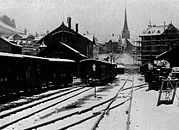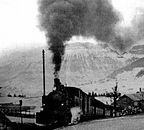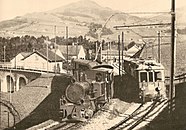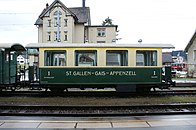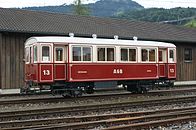St. Gallen-Gais-Appenzell-Altstätten Railway
The St. Gallen-Gais-Appenzell-Altstätten-Bahn (SGA) was a Swiss railway company that existed from 1889 to 1987. Before electrification in 1931, the railway was called the Appenzeller Strassenbahn (ASt). It was popularly known as the Gaiserbahn . They operated the meter-gauge and partly rack - and- pinion routes:
- St. Gallen – Appenzell and
- from 1947 Altstätten – Gais
On January 1, 1988 , it merged with the Appenzeller Bahn (AB) to form the Appenzeller Bahnen (AB).
Appenzell tram company
The St. Gallen - Gais route was opened on October 1, 1889 by the Appenzell tram (ASt) . The continuation from Gais to Appenzell followed on July 1, 1904. Although the ASt was primarily geared towards passenger traffic and served a dense network of stations, it was not an actual tram , but a mixed adhesion and cog railway .
prehistory
The narrow-gauge line from Winkeln via Herisau to Urnäsch was opened in 1875 as the first railway line in the canton of Appenzell Ausserrhoden . In 1886 it was continued to Appenzell . In the same year, the standard-gauge Rorschach-Heiden-Bergbahn (RHB) began operating.
Forces from the Appenzeller Mittelland campaigned for a rail connection from St. Gallen via Teufen and Bühler to Gais . The city of St. Gallen and the standard gauge United Swiss Railways (VSB), whose route ran from St. Gallen to Winterthur and Chur , were also interested in the construction of the railway. The precarious financial situation led to the idea of running the route as an overland tram , despite the constantly changing inclines and the narrow curves of the road. Adolf Klose , then a machine inspector at the VSB, developed a type of locomotive for mixed adhesion and gear drive and radial adjustment of the axles in curves ( Klose steering mechanism ). These machines with a track width of 75 cm could have negotiated curves with a radius of 20 meters and would have been suitable for the planned route.
In response to pressure from the authorities, the standard gauge of one meter was chosen, which increased the minimum radius to 30 meters. Klose adapted the locomotive design to the newly selected gauge. The Landsgemeinde Ausserrhoden approved in 1884 to move the railroad track to the state road. However, the street had to have a remaining width of 4.8 meters. St. Gallen prohibited the use of the city streets. That is why the route from St. Gallen train station to Riethüsli ran on its own route, which overcame the difference in altitude with a gradient of 92 per thousand at the time and a radius of 30 meters in the Ruckhalde curve.
Railway construction
After the establishment of the Appenzeller Strassenbahn-Gesellschaft (ASt) on September 7, 1887, construction could begin. Routes with a gradient of more than 45 per thousand were provided with racks from the Riggenbach-Klose system. The superstructure consisted of 9 meter long rails with a mass of 25 kg / m. Larger engineering structures were not required.
From November 1887 to April 1888, the earthworks in the water-rich and loamy Ruckhalde were stopped because there was fear of landslides when thawing. After the first locomotive arrived on Christmas 1888, it was initially used as a construction locomotive and from spring 1888 the Ruckhalde section was quickly completed. On September 30, 1889, the Appenzell tram line was officially opened.
Route at that time
The ASt had its starting point at that time in St. Gallen on the station square in front of today's main post office. There was no actual train station building there, but a modest “departure hall” with a turntable . The necessary office space was rented. After Leonhardsstrasse, which at that time still crossed the tracks with a level crossing, the four-track reloading facilities and sidings for the narrow-gauge railway were located in place of the SBB freight station. Until 1901, the ASt drove along what was then the only VSB line in the direction of Bruggen and only turned to the route that was used until 2018 in front of the St. Otmar church . From there, the rack-and-pinion section with the Ruckhalde curve rose around 80 meters. It allowed a beautiful view of the western parts of the city and was formerly an attraction for railway experts and tourists. At Riethüsli, the train crossed Teufenerstrasse and from here on to Gais remained mostly on the left of the road.
Shortly before the Lustmühle another rack section began as far as Niederteufen. Sternen is another stop before reaching Teufen train station. The passengers boarding at the stops could buy their tickets in the neighboring inn. So that the train staff noticed that someone was trying to get on, red reversible windows, later lamps, were attached to the facades. Until 1909 there was a short section of rack in front of Teufen station. Until then, the Teufen train station was opposite the church. The offices were rented in the former "Hôtel des Alpes", where the village library is now located. At the exit of the village after the Linde stop at the time, there is a gradient in front of the Goldibach bridge, which at that time was overcome using a rack. Not far from the former Rose stop, where tickets were sold in the restaurant of the same name, the Steigbach crossing station has been located since 1993 .
The Bühler station is on the right-hand side of the street, so that the train has to cross the street before and after the village. Until 1968, Bühler was an island train station ; the main track was on the street side, the crossing and freight track on the south side. The station building served, like that of Gais and later Bühler, at the same time for the post office and as a local switchboard for the telephone companies. A final gear section was used to overcome the incline between Bühler and Zweibrücken in the beam wood. The last section to the Gais terminus at the time is covered by the railway on its own route.
See also:
Today's route is in the section Description of the route of the article Railway line Appenzell – St. Gallen – Trogen .
Rack sections
During the construction of the line, the chief engineer Adolf Klose had the Riggenbach-Klose rack system he had developed for the first time on six sections with a total length of 3.2 kilometers. With the extension of the route to Appenzell, which contained the seventh and longest rack section, the total length increased in 1904 to 4.9 kilometers. But as early as 1909, the shortest section in Teufen became superfluous due to a re-routing.
Finally, between 1978 and 1983, five of the six rack sections were systematically removed through realignments. For the time being, there was only a one-kilometer rack section in the St. Gallen urban area between the train station and Riethüsli. It had a 180 ° turn with a radius of 30 m. There was not enough money at the time to replace it with a tunnel, for which there was a ready-to-run project in 1976. When the section was renewed, racks from the Riggenbach-Klose systems (original variant, newly manufactured for the 30-meter radius), Strub (as new racks from the Luchon-Superbagnères cable car ) and Von Roll (uppermost section, 234 m) were installed, which are compatible with each other. The modernization was completed by 1988.
The only remaining rack section after 1985 was built in the course of the construction of the Appenzell – St. Gallen – Trogen on Easter Monday 2018 for the last time and then dismantled. From October 2018 it was replaced by an adhesion section in the newly built Ruckhalde tunnel .
The following overview provides an overview of the length and pitch of the rack sections:
| No. | section | length | Slope 1 | Repeal | Measure | Inclination new |
|---|---|---|---|---|---|---|
| 1 | Ruckhalde, St.Gallen – Riethüsli | 978 m² | +92 ‰ | 2nd April 2018 | Modernization 1980/81, new cogwheel section 946 m, racks Riggenbach, Strub and Lamelle mixed | +100 ‰ |
| 2 | Watt – Lustmühle | 319 m | +52 ‰ | 1932 | Removal of the rack after electrification | +52 ‰ |
| 3 | Lustmühle – Niederteufen | 768 m 734 m³ |
+69 ‰ | September 25, 1985 | Removal of the rack | +69 ‰ |
| 4th | Old Teufen train station | 86 m | +90 ‰ | 1909 | Relocation of the station, track along the street | +38 ‰ |
| 5 | Lindenstich, Teufen – Goldibach Bridge | 360 m 4 | −86 ‰ | June 22, 1976 | Construction of a higher bridge for rail and road | −63 ‰ |
| 6th | Strahlholz, Bühler – Zweibrücken | 719 m | +87 ‰ | April 23, 1983 | New lines above instead of along the road | +60 ‰ |
| 7a | Rössli – Hirschberg | 1214 m | −63 ‰ | 1977/78 | Removal of the rack | −63 ‰ 5 |
| 7b | Hirschberg – Sitterbrücke Appenzell | 444 m | −82 ‰ | May 27, 1978 | New line, 572 m longer | −50 ‰ |
|
1 Positive value = incline towards Appenzell, negative value = incline towards St. Gallen 2 Value according to source [1], p. 21, according to source [3] before repeal 997 m |
||||||
Rolling stock

The support tender locomotives HG 2/3 1–4 with radially adjustable axles, designed by Klose and supplied by the Schweizerische Lokomotiv- und Maschinenfabrik (SLM), were the first four-cylinder compound locomotives in the world. The execution turned out to be difficult because of the new Klose steering axles . The first three locomotives were named Gais, Teufen and Bühler . The straggler No. 4, which was delivered in 1890 because of the good frequency, was named St. Gallen . The complicated locomotives only partially proved their worth. They were heavily used, which was reflected in the costly maintenance and the many disruptions.
The wagons designed by Klose were built by the VSB workshop in Chur. All of the cars had Klose air brakes and were triaxial. The middle axis was equipped with a gear brake, the two end axes with adhesion brakes.
Continuation to Appenzell

In 1898 an electric tram was planned from Gais to Appenzell and on towards Alpstein . The concession for this expired in 1902. So the Appenzell tram took the initiative to build a railway to Appenzell, again using the road.
The construction work to continue to Appenzell began on August 10, 1903. The most complex part was the construction of the 296 meter long Sitter Viaduct near Appenzell, which until 2010 was the longest narrow-gauge railway bridge in Switzerland. Initially, the intention was to create a separate ASt station on the right side of the Sitter in order to save the construction of a Sitter bridge. The professional ethics committee resisted and spoke out in favor of the bridge. The Appenzeller Bahn (AB) was not happy about the competition and asked the ASt to build its own section of the station with a turntable, locomotive depot and car shed on the east side of the station. For the crossing of the Sitter, dams connected by iron bridges were provided. Because the intended fill material was too loamy, a viaduct with 32 brick arches, a road overpass and a steel middle section 48 meters long were built.
The line from Gais to Appenzell was opened on July 1, 1904. It leaves the Gais train station to the east and turns in a tight curve initially on its own route to the west. After about three kilometers along the road, the train arrives at the assembly point . Now a continuous rack followed past the Hirschberg stop to the beginning of the Sitter Viaduct. After the viaduct, the trains enter Appenzell station.
Two steam locomotives HG 2/4 No. 5 and 6 had to be procured for the line extended to Appenzell . The two machines were designed and built by SLM in Winterthur and were the first locomotives with a drive based on the Winterthur system. In 1909 two steam locomotives of the same design were delivered. For this, after only 20 years of operation, the No. 1, which had already been used as a construction locomotive, was scrapped. In the years between 1904 and 1913, additional passenger and freight cars were purchased, some of which are still in service today as historic cars.
Train coming from Appenzell with a HG 2/4 at the Hirschberg stop
Trains of the ASt and the Säntisbahn (SB), which opened in 1912, at the entrance to Appenzell station
The first years of operation
ASt's tourist traffic developed positively - in contrast to freight traffic. Nevertheless, the ASt had to overcome some initial financial difficulties. The financial situation stabilized towards the end of the 1890s. The extension to Appenzell brought a further boost to traffic.
The relocation of the Teufen train station to its current location made it possible to remove a short rack section. The post office and the local switchboard were located in the basement of the spacious building from 1909, and the ASt management and service apartments were located on the upper floor. Another addition to the station facilities was the opening of the narrow-gauge Altstätten-Gais-Bahn (AG) in 1911 . It began at the Altstätten SBB train station and used the Altstätten – Berneck tramway to Altstätten Stadt . Gais became the operational center and was given a new, larger station building in connection with the new line to Altstätten in 1911. The Altstätten-Gais-Bahn, operated electrically from the beginning with 1000 volts direct current , used platform 1 in Gais then as it does today.
There were major changes in St. Gallen with the construction of the new train station. The construction of the extensive freight station in 1901 led to the relocation of the ASt line with two new tight curves. From 1910 to 1914 various construction phases followed for the relocation of the ASt and the new departure point. The secondary station, which is still in operation today, was built by the city in 1914 and, thanks to a connecting wing, enables covered access to the SBB facilities. The covered platform on the north side was used by the Trogenerbahn (TB) trains . On the south side, the ASt had a three-track system with a turntable on the east side. Up to around 1980 there was a track connection - albeit rarely used - between TB and SGA in the area of the sidings.
The opening of the Säntisbahn Appenzell – Wasserauen electrified with 1000 volts direct current on July 13, 1912 led to a further increase in tourist traffic. With the beginning of the First World War , the ASt got into financial difficulties. Income, especially from passenger traffic, collapsed immediately. The operating results were no longer sufficient to pay the interest . In 1922 the ASt had to be financially restructured, with 80 percent of the share capital value being written off. Even afterwards, the economic situation did not allow a change for the better.
Electric train from St. Gallen to Gais to Appenzell


The ASt was electrified and the name changed to St. Gallen-Gais-Appenzell Electric Railway, or St. Gallen-Gais-Appenzell Railway for short (SGA). Electrical operation with 1500 volts direct current began on January 23, 1931.
electrification
On March 20, 1929, the board of directors made the decision to electrify the Gaiserbahn. This not only made it possible to rationalize operations, but also freed the villages through which they passed from the plague of smoke. The difficult route with the tight curves required new solutions for the construction of the electric railcars . Five BCFeh 4/4 1–5 were purchased for mixed adhesion and gear operation. The five green / cream-colored railcars with the later designation ABDeh 4/4 dominated the image of the SGA for fifty years after electrification. When the traffic was light, they made it possible for single drivers to operate cheaper than a train hauled by a locomotive. Thanks to their top speed of 40 km / h, they were able to shorten travel times compared to steam traction.
The St. Gallisch-Appenzellische Kraftwerke (SAK) supply the electricity for rail operations to the two rectifier stations in Niederteufen and Gais. Each substation comprised a rectifier group with 600 kW continuous output. Major adjustments were necessary in the train stations, whereby in St. Gallen, Gais and Appenzell consideration had to be given to the existing contact lines of the neighboring railways with different power systems. The steam locomotives and the turntables in St. Gallen, Gais and Appenzell were demolished after electrification and the rack on the 319 meter long section Watt – Lustmühle with a 52 ‰ gradient was removed.
Today the contact line is supplied by the rectifier stations Liebegg, Niederteufen, Gais and Appenzell. The network can also be fed from the rectifier in Altstätten.
St. Gallen-Gais-Appenzell-Altstätten Railway
On January 1, 1947, the SGA merged with the Altstätten-Gais-Bahn (AG) opened in 1911 to form the St. Gallen-Gais-Appenzell-Altstätten-Bahn (SGA).
| SGA BCFeh 4/4 6-8 | |
|---|---|
|
ABDeh 4/4 6 in 1986 in Altstätten city
|
|
| Numbering: | 6-8 |
| Manufacturer: | SLM , BBC |
| Year of construction (s): | 1953 |
| Axis formula : | Bbo'Bbo ' |
| Genre : | from 1962: ABDeh 4/4 |
| Gauge : | 1000 mm ( meter gauge ) |
| Length over coupling: | 15 800 mm |
| Total wheelbase: | 12 615 mm |
| Loading mass: | 1.5 t |
| Service mass: | 35.6 t |
| Friction mass: | 35.6 t |
| Top speed: | 50 km / h ( adhesion ) 30 km / h ( gear ) |
| Hourly output : | 472 kW (642 hp ) |
| Driving wheel diameter: | 678 mm |
| Gear system : |
Riggenbach-Klose , Strub, Von Roll |
| Power system : | 1500 V = |
| Number of traction motors: | 4th |
| Seats: | 6 + 32 |
| Classes : | 1st and 2nd class |
Merger with the Altstätten-Gais-Bahn

The question of converting to bus operation occupied those responsible at SGA for decades. After the Second World War it was expected that the railways' accounts would deteriorate. The Private Railway Aid Act therefore made it possible to renovate railway companies, but also called for rationalization measures. In the two cantons of Appenzell, the aim was to merge four different railway companies. But only two mergers of two succeed. On January 1, 1948, the Altstätten-Gais-Bahn (AG) joined the SGA and the Säntisbahn joined the Appenzeller Bahn.
The federal aid of 2.1 million francs was used to renew the Altstätten – Gais line and to purchase three BCFeh 4/4 No. 6-8 railcars and three C4ü 70-73 light steel cars . The railcars with rigidly coupled adhesion and gear drive heralded a new era. They could run on all existing cogwheel routes, on the Altstätten – Gais section with a gradient of 160 ‰ and on the St. Gallen – Appenzell route with a gradient of up to 100 ‰. The name was later changed to ABDeh 4/4 6–8. ABDeh 4/4 6 has had the name and coat of arms of the Altstätten community since 1986.
To standardize the power system of the SGA, the contact line voltage of the AG line was increased from 1000 volts to 1500 volts. Of the existing CFe 3/3 1-3 and CFe 4/4 4 railcars , only number 2 was adapted to the new voltage.
The struggle for survival
The survival of the Gaiserbahn was hemmed in by a large number of reports, which several times recommended switching to road. An expertise was carried out before every major investment. In 1964, three B 81–83 passenger cars could still be purchased from their own resources. Then the SGA's accounts became deficits. The experts were still concerned with the question of trains or buses. In 1970 a decisive report was then available which recommended keeping the railway and switching to adhesion operation.
In Altstätten, the SGA made the obstacles caused by road traffic to create. After the Rheintalische Verkehrsbetriebe stopped tram operation on the remaining section on June 2, 1973 , the SGA also decided to stop serving the Altstätten SBB – Altstätten Stadt section from June 1, 1975.
Rollbuck operation
In order to be able to transport standard-gauge wagons on the meter -gauge network, a roll- stand system went into operation in Gossau as early as July 1, 1978 . With the elimination of most of the rack sections, the roll stand operation was expanded in 1989 to the Appenzell – Gais section and on June 1, 1990 to the Gais – Teufen section . Due to falling volumes, SBB Cargo stopped operating the AB meter-gauge network at the end of 2003, and at the end of July 2010 the trolley system was shut down.
Rehabilitation of the St. Gallen – Appenzell line
The St. Gallen – Appenzell line had to be almost completely renewed. The conversion of the St. Gallen – Riethüsli section to adhesion operation could not be implemented for the time being. The planned Riethüsli tunnel would have been more expensive than originally planned, so its construction was postponed. This cogwheel section was canceled on October 7, 2018 with the opening of the Ruckhalde tunnel .
Thanks to the new construction of the now elevated Goldibach bridge between Teufen and Bühler, the gradient was reduced to 62 ‰ and the rack was dispensed with since June 22, 1976. The removal of the rack section beam wood between Bühler and Gais required a major line correction, which was put into operation on April 23, 1983. In the Appenzell-Hirschberg area, the rack was removed in 1977 and 1978. For this purpose, the route was extended by 372 meters. The new line with the so-called Hirschberg loop was inaugurated on May 27, 1979. It gives travelers a good view of the Alpstein and the Appenzell basin.

In 1980/81 the SGA renovated the remaining rack section Ruckhalde and reconstructed the slope drainage. The lines were corrected slightly, which increased the gradient to 100 ‰. Because of the difficult procurement of the racks, the Strub and Von Roll systems have been used on this section since then . The narrow radius of the Ruckhalde curve of 30 meters did not allow the use of the Strub rack, and SGA built racks of the Riggenbach system.
In 1981 the vehicle fleet was renewed with the four BDeh 4/4 11-14 commuter trains and the associated ABt 111-114 control car. A fifth identical composition was initially bought at the expense of the Appenzeller Bahn and left to the SGA. In 1986 it was officially included in the SGA. Two more shuttle trains, which can also go to Altstätten, were delivered in 1993. These shuttle trains, mostly with an intermediate car, handle the traffic between St. Gallen and Appenzell today.
The efforts to separate the two modes of transport with increasing road and rail traffic lasted decades and have not yet been completed. In most cases, due road renewals allowed the railway to move away from the carriageway on its own route at the edge of the road.
From 1983 to 1985, Appenzell train station was redesigned and built. In 1989, the portals of the Sitter Viaduct had to be expanded so that the freight wagons loaded on trolleys could be transported from Appenzell to Gais and Teufen.
Merger to form the Appenzeller Bahnen
In 1970 the SGA and the Appenzeller Bahn (AB) created a joint management team after the SGA had initially resisted any cooperation for years. In the course of time, the operation of the two railways was standardized. On January 1, 1988, they finally merged to form Appenzeller Bahnen (AB).
Historic car park
The SGA's passenger car park was quite colorful. In addition to the 13 three-axle vehicles from the early days, four-axle vehicles and converted Brünig wagons were used after 1913 . SGA trains often ran with one or two passenger cars and a baggage car that was only 8 meters long. In consideration of the road use, which once prevailed and which still exists in Teufen today, the wagons had no toilets.
The freight wagons also had a three-axle steering axle underframe. Originally there were 16. In 1899/1904 another 12 were added, as well as three optional cars . From the inventory of the Altstätten-Gais-Bahn three two-axle passenger cars, two covered and two open freight cars came to the SGA. In 1954, two boxcars that had been taken over by the SBB (Brünigbahn) came into operation. Various freight cars were also converted into company cars. In 1985 the goods wagons were scrapped; today there are only a few examples left as historical vehicles or for service purposes.
It is thanks to the financial problems of the railway since the 1920s that many vehicles were not scrapped but kept in reserve. The Appenzeller Railways have an almost complete collection of historic vehicles. Although the steam locomotives were broken off after electrification, many of the Appenzell tram cars have been preserved.
swell
- Josef Hardegger: 100 years of the Gaiserbahn, 1889–1989 . Verlag Schläpfer, Herisau 1989, ISBN 3-85882-063-6 .
- Thomas Frey, Hans-Ulrich Schiedt: Appenzell tram. In: bahndaten.ch, data on the Swiss railways 1847–1920. Via Storia, Center for Transport History at the University of Bern, accessed on November 30, 2015 .
- The extension of the Appenzell tram from Gais to Appenzell. In: Schweizerische Bauzeitung . Volume 45 (1905), Issue 24 (archived in E-Periodica of the ETH Library , PDF; 4.0 MB).
- The railcars and substations of the electr. Train St. Gallen-Gais-Appenzell. In: Schweizerische Bauzeitung. Volume 100 (1932), Issue 21 (archived in E-Periodica of the ETH-Bibliothek , PDF; 5.0 MB).
Web links
- Appenzeller Bahnen (ex SGA). St. Gallen Ruckhalde – Riethüsli. On: discontinued railways in Switzerland .
Notes and individual references
- ^ Josef Hardegger: Tradition & Progress of Appenzeller Bahnen AB / SGA. Verlag Appenzeller Bahnen AB / SGA, Herisau 1981, pp. 13-17.
- ↑ Finally the green light for the St. Gallen diameter line . In: Swiss Railway Review . No. 1 . Minirex, 2016, ISSN 1022-7113 , p. 12 .
- ↑ From 1956 B 70–73. They correspond to the B 81–83, which were subsequently procured in 1964.
- ↑ Construction work on the Ruckhalde: The hole will soon be a tunnel. St. Galler Tagblatt , March 3, 2018, accessed on August 9, 2018 .










